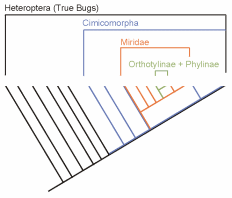Some morphological aspects of the Miridae
Even though coverage of the wealth of morphological structures used in the classification of the Heteroptera is far beyond the scope of this short introduction to the group, a summary of at least some of the structures used to recognize the Miridae as well as those that show significant morphological variation in the group seems useful at this point.
The Miridae are unique within the Heteroptera in their possession of specialized setae known as trichobothria on the middle and hind femora. Most species lack the pair of ocelli found situated between the compound eyes of the majority of heteropteran species; the exception to this rule is the subfamily Isometopinae, which is thought to be the sister group of all remaining Miridae (the most basal lineage). The hemelytra, or forewings, nearly always have a well-demarcated cuneus, a triangular structure that is found in some other groups such as the non-parasitic Cimicoidea (bed bugs and their relatives) and whose anterior margin if formed by the costal fracture.
The pretarsus (claws and associated structures) shows much greater variation in the Miridae than in most other hemipterans, and provides many features crucial for understanding the subfamily classification of the group. As in most other bugs, the claws in the Miridae are symmetrical, the right and left claws being similarly developed. They may bear a pulvillus, a fleshy pad, on the ventral or interior surface of the claw; the exterior claw surface is sometimes ornamented with a few claw hairs of variable length. Between the claws are found the parempodia, paired, structures that arise from the distal end of the unquitractor plate. The parempodia are frequently in the form of common setae and are symmetrically developed. They may also be weakly to rather strongly fleshy and either divergent or convergent apically. Also present in some Miridae are structures known as pseudopulvilli that arise from the base of the claws. In some groups the pseudopulvilli have the appearance of parempodia whereas in others they look more like pulvilli.
Many lineages within the Miridae have species that are antlike in appearance. These myrmecomorphic taxa show a variety of modifications in coloration, morphology, and setation that lend to their sometimes remarkably antlike appearance. The most typical changes are modifications to the head and the hemelytra.
The male genitalia in the Miridae have long been known to be useful for distinguishing species of Miridae. They comprise the following structures: two parameres, structures that apparently serve a sensory, and possibly clasping, function during copulation; the phallus, which is formed by a basal plate and the aedeagus. The endomosoma, or actual intromittent organ, is usually referred to as the vesica in the Miridae and is housed in the phallotheca when in repose. All of these structures, with the exception of the phallobase, are asymmetrical in structure, sometimes dramatically so.
The female genitalia, although showing significant morphological variation within the Miridae, have been less widely used as taxonomic characters than have the male structures. The ovipositor is laciniate, or bladelike, with two sets of sawlike valves that allow the bugs to insert their eggs into plant tissues. At the base of the interior (or anterior) valves is located the posterior wall, a sclerotized plate that may be simple and unornamented, may bear fields of spicules , or may be more structurally elaborate and bear what have been called K-structures.
Some biological aspects of the Miridae
The biologies, or life histories, of plant bugs have been most extensively studied for species in the temperate latitudes and for those tropical species that are of importance in agriculture. In the temperate latitudes the preponderance of species are univoltine, having a single generation per year and passing the winter in the egg stage. Most species are phytophagous and associated with developing meristematic tissues or with flowers and are therefore observed when plants are actively producing new foliage or flowers. Many species are host specific and feed on woody, perennial plant species. Some lineages of Miridae, such as the Isometopinae and Deraeocorinae, are predatory and have life cycles that are apparently strongly associated with the life cycles of their prey as opposed to the active growing period of plants. Even the predatory species are often specific to a give plant species, apparently as a reflection of the host specificity of their prey. A smaller number of mirid species appear to be more general feeders or feed on both animal and plant matter. These and some others may be multivoltine, producing more than one generation per year.
Host associations in the Miridae show some broad patterns, and clearly indicate that the bugs have radiated on certain plant groups while being completely absent from others. For example, some lineages are restricted to the Monocotyledoneae. These include the grass bugs, or Stenodemini, most Haltincini where many species also feed on grasses, the grass-feeding phyline genera Lopus, Amblytus, and Conostethus, and many genera of Eccritotarsini which feed on groups such as the Orchidaceae, Araceae, and Musaceae. A very few genera of Miridae feed on ferns, but most occur on seed plants, and most of those are found on the Angiospermae. Nonetheless, the coniferous families Cupressaceae and Pinaceae harbor a very large number of genera and species, but these do not belong to monophyletic groups, but rather are spread over a large number of lineages, the remaining members of which feed on "dicots".




